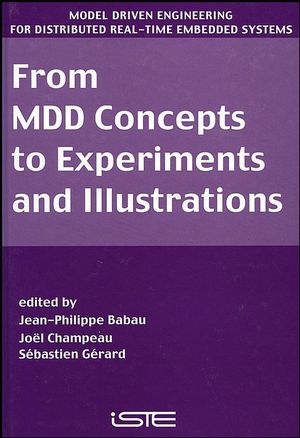From MDD Concepts to Experiments and IllustrationsISBN: 978-1-905209-59-0
Hardcover
256 pages
September 2006, Wiley-ISTE
 |
||||||
Chapter 1. On Metamodels and Language Engineering
(Pierre-Alain Muller).
1.1 Introduction.
1.2 Modeling Abstract Syntax.
1.3 Modeling Operational Semantics.
1.4 Modeling Concrete Syntax.
1.5 Related Works.
1.6 References.
Chapter 2. Using Directives to Implement Model
Transformations (Devon Simmonds et al).
2.1 Introduction.
2.2 Model Transformation Using Embedded Directives.
2.3 Transformations Directives.
2.4 Transformation Schemas.
2.5 Class Model Transformation - Illustration Example.
2.6 Discussion and Conclusion.
2.7 References.
Chapter 3. Rationale of the UML Profile for Marte
(Sébastien Gérard and Huascar Espinoza).
3.1 Introduction.
3.2 Outlines of Marte.
3.3 Profile Architecture.
3.4 References.
Chapter 4. From UML to Performance Analysis Models by
Abstraction-raising Transformation (Dorina Petriu and Antonino
Sabetta).
4.1 Introduction.
4.2 Conceptual Approach for Abstracting-raising
Transformation.
4.3 Two-step Abstracting-raising Transformation.
4.4 Two-step Abstration-raising Transformation.
4.5 Application of the Proposed Transformation.
4.6 Conclusion.
4.7 References.
Chapter 5. Component-Based Software Engineering for Embedded
Systems (Ivica Crnkovic).
5.1 Embedded Systems.
5.2 Specfic Requirement and Aspects of Embedded Systems.
5.3 Component-based Basic Concepts for Embedded Systems.
5.4 Specfic Demands on Component-based Software Engineering.
5.5 State of the CBSE Practice and Experience for Embedded
Systems.
5.6 Work on Standardization.
5.7 The Needs and Priorities in Research.
5.8 References.
Chapter 6. Model Driven Engineering for System-on-Chip
Design (Pierre Boulet et al).
6.1 Introduction.
6.2 SoC Design Challenges and Model Driven Engineering.
6.3 UML Profiles for SoC Design.
6.4 MDE Approach to SoC Design.
6.5 Gaspard2 Development Environment.
6.6 Conclusion.
6.7 References.
Chapter 7. Schedulability Analysis and MDD (Samuel Rouxel
et al).
7.1 Introduction.
7.2 Related Work.
7.3 Global Approach.
7.4 UML Modeling.
7.5 Real Time Analysis Tool (RTDT).
7.6 UMTS FDD Case Study.
7.7 Conclusion.
7.8 Acknowledgements.
7.9 References.
Chapter 8. Model Driven Testing of Time Sensitive Distributed
Systems (Borislav Gajanovic, Hans Grönniger and Bernhard
Rumpe).
8.1 Model Driven Testing.
8.2 Asynchronous Communication in Distributed Systems.
8.3 The Alternative Bit Protocol.
8.4 Strategies for Testing Distributed, Asynchronously
Communicating Systems.
8.5 Implementing Tests in Haskell.
8.6 Discussion of Results.
8.7 References.
Chapter 9. Model Management for Formal Validation
(Joël Champeau et al).
9.1 Introduction.
9.2 System Modeling Framework.
9.3 Building Models for Formal Verification.
9.4 Conclusion and Future Work.
9.5 References.
Chapter 10. The Design of Space Systems (David
Chemouil).
10.1 Introduction.
10.2 Space Systems.
10.3 Design.
10.4 Modelling.
10.5 Conclusion.
10.6 References.
Chapter 11. TOPCASED: An Open Source Development Environment
for Embbeded Systems (Patrick Farail et al).
11.1 Introduction.
11.2 Requirements and TOPCASED Architecture.
11.3 Model Driven Engineering and Meta-modeling.
11.4 Generating Model Editors.
11.5 Acknowledgment.
11.6 References.
11.7 Glossary.
Chapter 12. Facing Industrial Challenges: A Return on an
Experiment on Modeldriven Engineering (Jean-Luc Voirin).
12.1 Introduction.
12.2 A Quick Overview of Our Understanding of MDE.
12.3 Expected Benefits of Model-driven Engineering.
12.4 Applying MDE Concepts in an Industrial Context.
12.5 Return of Experiment and Findings on MDE Use.
12.6 Conclusion: So What About MDE?
Index of Authors.



